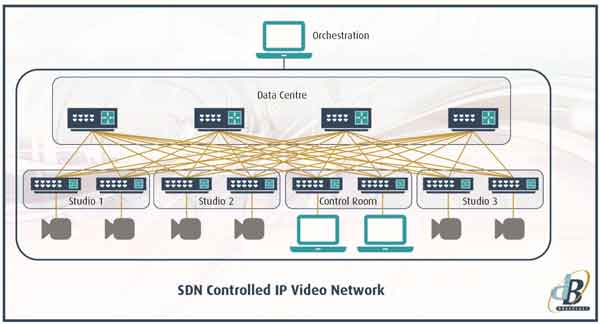Broadcast News
05/07/2018
Importance of SDNs, Orchestration And NMOS in Broadcast Networks

In this article, dB Broadcast discusses the importance of orchestration in broadcast networks. This is based on dB Broadcast's unique experience in designing and implementing IP solutions for broadcasting, and its work on state of the art projects for clients including Bloomberg Television and BBC Wales.
Recently there has been much talk in our industry (and especially at trade shows) about the term ‘orchestration’. But what does orchestration mean, and what are the implications for the deployment of IP Video production networks?
Put simply: orchestration is the automation of the workflows and processes within a network.
To provide easier interoperability and configurability within IP networks, there has been a trend towards the use of Software Defined Networks (SDNs), which allow networks to be programmatically configured and managed. This programmatic capability is required to minimise provisioning times for reconfigured services.
Network orchestration - otherwise known as SDN orchestration - is the ability to use an SDN controller automatically to control the behaviour of the network. This is achieved by coordinating the hardware and software network elements required to support specified applications and services. This could include for example, capacity and bandwidth management, as well as congestion avoidance.
Service orchestration separates the network services from the network components, automatically configuring the network to provision specified services. Service orchestration reduces the time taken to design and deploy new services, and enables real-time service provisioning.
In IP Video networks, both service and network orchestration are important considerations. It should be remembered that one of the key advantages of an IP network, when compared with an SDI network, is that connections between devices are established logically rather than physically. In a previous White Paper, we considered how the flexibility and scalability of leaf-spine networks make them likely to become the norm in IP video applications. It is this flexibility that will allow network resources to be centralised, and to be logically reconfigured for different production applications.
This obviously implies that different media resources will need to be connected to each other under software control in very different configurations, depending on the individual production requirements.
To provide standardisation for the interoperable automated configuration and management of networked media flows, the Advanced Media Workflow Association (AMWA) is developing a suite of open specifications known as the Networked Media Open Specifications (NMOS). These provide an open set of APIs to support interoperability for networked media applications. Where possible, AMWA’s specifications are designed to use internet friendly protocols.
NMOS consists of three Interface Specifications: IS-04, IS-05 and the future IS-06.
AMWA has already published the IS-04 specification, which offers a mechanism to automatically discover and register broadcast resources within an IP network. IS-04 uses HTTP for the registration, query and node APIs. The node API is used for ‘peer-to-peer’ discovery where no registry is available. All APIs are announced using DNS Service Discovery (DNS-SD).
IS-04 provides the first step towards service orchestration, greatly simplifying system configuration, and is already being integrated into vendors' products.
Once broadcast devices have been discovered and registered, there needs to be a mechanism for connection management of these resources. The published IS-05 specification complements IS-04 to provide a system to manage connections between senders and receivers. These can be scheduled or ad hoc, and the specification does not mandate the use of an SDN controller, so it is possible to use both IS-04 and IS-05 with a traditional-style router control panel.
The final specification, IS-06 is a work in progress and is intended to provide specifications for network control. It can be considered as being a "north-bound" API for SDN controllers. The intention is to provide an API that describes the network topology, and enables reservation of bandwidth for capacity management.
In the past, SDN Control and service orchestration could only be implemented using proprietary means. The NMOS open specifications are intended to replace these proprietary equipment interfaces with non-proprietary means, making configuration, management and interoperability of multi-vendor networks much simpler.
This article is also available in the July edition of Broadcast Film & Video. Available here.
Recently there has been much talk in our industry (and especially at trade shows) about the term ‘orchestration’. But what does orchestration mean, and what are the implications for the deployment of IP Video production networks?
Put simply: orchestration is the automation of the workflows and processes within a network.
To provide easier interoperability and configurability within IP networks, there has been a trend towards the use of Software Defined Networks (SDNs), which allow networks to be programmatically configured and managed. This programmatic capability is required to minimise provisioning times for reconfigured services.
Network orchestration - otherwise known as SDN orchestration - is the ability to use an SDN controller automatically to control the behaviour of the network. This is achieved by coordinating the hardware and software network elements required to support specified applications and services. This could include for example, capacity and bandwidth management, as well as congestion avoidance.
Service orchestration separates the network services from the network components, automatically configuring the network to provision specified services. Service orchestration reduces the time taken to design and deploy new services, and enables real-time service provisioning.
In IP Video networks, both service and network orchestration are important considerations. It should be remembered that one of the key advantages of an IP network, when compared with an SDI network, is that connections between devices are established logically rather than physically. In a previous White Paper, we considered how the flexibility and scalability of leaf-spine networks make them likely to become the norm in IP video applications. It is this flexibility that will allow network resources to be centralised, and to be logically reconfigured for different production applications.
This obviously implies that different media resources will need to be connected to each other under software control in very different configurations, depending on the individual production requirements.
To provide standardisation for the interoperable automated configuration and management of networked media flows, the Advanced Media Workflow Association (AMWA) is developing a suite of open specifications known as the Networked Media Open Specifications (NMOS). These provide an open set of APIs to support interoperability for networked media applications. Where possible, AMWA’s specifications are designed to use internet friendly protocols.
NMOS consists of three Interface Specifications: IS-04, IS-05 and the future IS-06.
AMWA has already published the IS-04 specification, which offers a mechanism to automatically discover and register broadcast resources within an IP network. IS-04 uses HTTP for the registration, query and node APIs. The node API is used for ‘peer-to-peer’ discovery where no registry is available. All APIs are announced using DNS Service Discovery (DNS-SD).
IS-04 provides the first step towards service orchestration, greatly simplifying system configuration, and is already being integrated into vendors' products.
Once broadcast devices have been discovered and registered, there needs to be a mechanism for connection management of these resources. The published IS-05 specification complements IS-04 to provide a system to manage connections between senders and receivers. These can be scheduled or ad hoc, and the specification does not mandate the use of an SDN controller, so it is possible to use both IS-04 and IS-05 with a traditional-style router control panel.
The final specification, IS-06 is a work in progress and is intended to provide specifications for network control. It can be considered as being a "north-bound" API for SDN controllers. The intention is to provide an API that describes the network topology, and enables reservation of bandwidth for capacity management.
In the past, SDN Control and service orchestration could only be implemented using proprietary means. The NMOS open specifications are intended to replace these proprietary equipment interfaces with non-proprietary means, making configuration, management and interoperability of multi-vendor networks much simpler.
This article is also available in the July edition of Broadcast Film & Video. Available here.
Useful Links
Top Related Stories
Click here for the latest broadcast news stories.
18/01/2008
Broadcast Networks Provides Technical Services For Genesis Networks
System integration specialist Broadcast Networks is helping network provider Genesis Networks to deliver new services to its customers by providing ge
Broadcast Networks Provides Technical Services For Genesis Networks
System integration specialist Broadcast Networks is helping network provider Genesis Networks to deliver new services to its customers by providing ge
01/07/2005
Siemens Business Services to provide satellite services to Live8
Siemens Business Services has announced that it will deliver record-breaking satellite services for the largest global live transmission in history –
Siemens Business Services to provide satellite services to Live8
Siemens Business Services has announced that it will deliver record-breaking satellite services for the largest global live transmission in history –
19/07/2024
LiveU & Pente Networks Democratise Private Cellular Networks
The race to the US Presidential Election continues to heat up further this summer with the recent Republican National Convention this week in Wisconsi
LiveU & Pente Networks Democratise Private Cellular Networks
The race to the US Presidential Election continues to heat up further this summer with the recent Republican National Convention this week in Wisconsi
22/08/2006
Food Networks HD and HGTV HD networks launch on Omneon Spectrum
Omneon Video Networks have announced that Scripps Networks has launched its Food Network HD and HGTV HD networks, as well as its Great American Countr
Food Networks HD and HGTV HD networks launch on Omneon Spectrum
Omneon Video Networks have announced that Scripps Networks has launched its Food Network HD and HGTV HD networks, as well as its Great American Countr
09/08/2012
Supersonic Networks Introduces Digital Cable Services
Harmonic, the worldwide leader in video delivery infrastructure, today announced that North Indian cable operator Supersonic Networks has installed a
Supersonic Networks Introduces Digital Cable Services
Harmonic, the worldwide leader in video delivery infrastructure, today announced that North Indian cable operator Supersonic Networks has installed a
07/06/2012
Belgium's Alpha Networks Selects Harmonic To Power IPTV And OTT Multiscreen Video Services
Harmonic Inc has announced that Belgian telecom operator Alpha Networks has launched its Billi IPTV and OTT services, as well as hosted service offeri
Belgium's Alpha Networks Selects Harmonic To Power IPTV And OTT Multiscreen Video Services
Harmonic Inc has announced that Belgian telecom operator Alpha Networks has launched its Billi IPTV and OTT services, as well as hosted service offeri
01/04/2011
France Télévisions Launches DTV Services For Overseas Territories With Thomson Video Networks Solution
Thomson Video Networks has announced that France Télévisions has launched DTV services for French-administered overseas territories, using an extensiv
France Télévisions Launches DTV Services For Overseas Territories With Thomson Video Networks Solution
Thomson Video Networks has announced that France Télévisions has launched DTV services for French-administered overseas territories, using an extensiv
28/10/2008
Genesis Networks Offer Turnkey Broadcasting Services For US Presidential Election Coverage
Genesis Networks, a leading provider of high-quality global transmission services, has announced that it has expanded its broadcasting package for med
Genesis Networks Offer Turnkey Broadcasting Services For US Presidential Election Coverage
Genesis Networks, a leading provider of high-quality global transmission services, has announced that it has expanded its broadcasting package for med
19/02/2020
Visual Data Media Services Acquires Digital Post Services
Visual Data Media Services has acquired Hollywood-based Digital Post Services (DPS) as part of its global acquisitions strategy. DPS has a well-establ
Visual Data Media Services Acquires Digital Post Services
Visual Data Media Services has acquired Hollywood-based Digital Post Services (DPS) as part of its global acquisitions strategy. DPS has a well-establ
21/04/2006
American Cable Services deploy VoX services
VoX Communications, wholesale and retail provider of Voice over Internet Protocol (VoIP) services nationwide, has announced that American Cable Servic
American Cable Services deploy VoX services
VoX Communications, wholesale and retail provider of Voice over Internet Protocol (VoIP) services nationwide, has announced that American Cable Servic
12/09/2005
Ascent Media Network Services appoint head of consulting services arm
Ascent Media Network Services (AMNS) has announced the creation of a strategic consulting practice to augment its global Systems & Technology Services
Ascent Media Network Services appoint head of consulting services arm
Ascent Media Network Services (AMNS) has announced the creation of a strategic consulting practice to augment its global Systems & Technology Services
03/09/2024
EMG / Gravity Media To PRovide Broadcast Services To NBC Sports
EMG / Gravity Media is to provide broadcast services to NBC Sports for the Peacock Exclusive NFL game in São Paulo, Brazil, the first ever NFL game to
EMG / Gravity Media To PRovide Broadcast Services To NBC Sports
EMG / Gravity Media is to provide broadcast services to NBC Sports for the Peacock Exclusive NFL game in São Paulo, Brazil, the first ever NFL game to
11/03/2004
BBC Technology to provide consulting services to new Caribbean broadcast network
BBC Technology has been selected to deliver a five-year business plan to the New National Broadcast Network of Trinidad and Tobago (New NBN). The Nati
BBC Technology to provide consulting services to new Caribbean broadcast network
BBC Technology has been selected to deliver a five-year business plan to the New National Broadcast Network of Trinidad and Tobago (New NBN). The Nati
30/03/2022
Nevion Adds Broadcast Control Functionality To Its VideoIPath Media Orchestration Platform
Nevion, a Sony Group Company and award-winning provider of virtualized media production solutions, is adding essential broadcast control functionality
Nevion Adds Broadcast Control Functionality To Its VideoIPath Media Orchestration Platform
Nevion, a Sony Group Company and award-winning provider of virtualized media production solutions, is adding essential broadcast control functionality
19/10/2018
Broadpeak And Inca Networks Partner To Provide HBC With IP Video Delivery Solution
Broadpeak® and Inca Networks have partnered to provide Minnesota-based internet service provider Hiawatha Broadband Communications (HBC) with a reliab
Broadpeak And Inca Networks Partner To Provide HBC With IP Video Delivery Solution
Broadpeak® and Inca Networks have partnered to provide Minnesota-based internet service provider Hiawatha Broadband Communications (HBC) with a reliab















